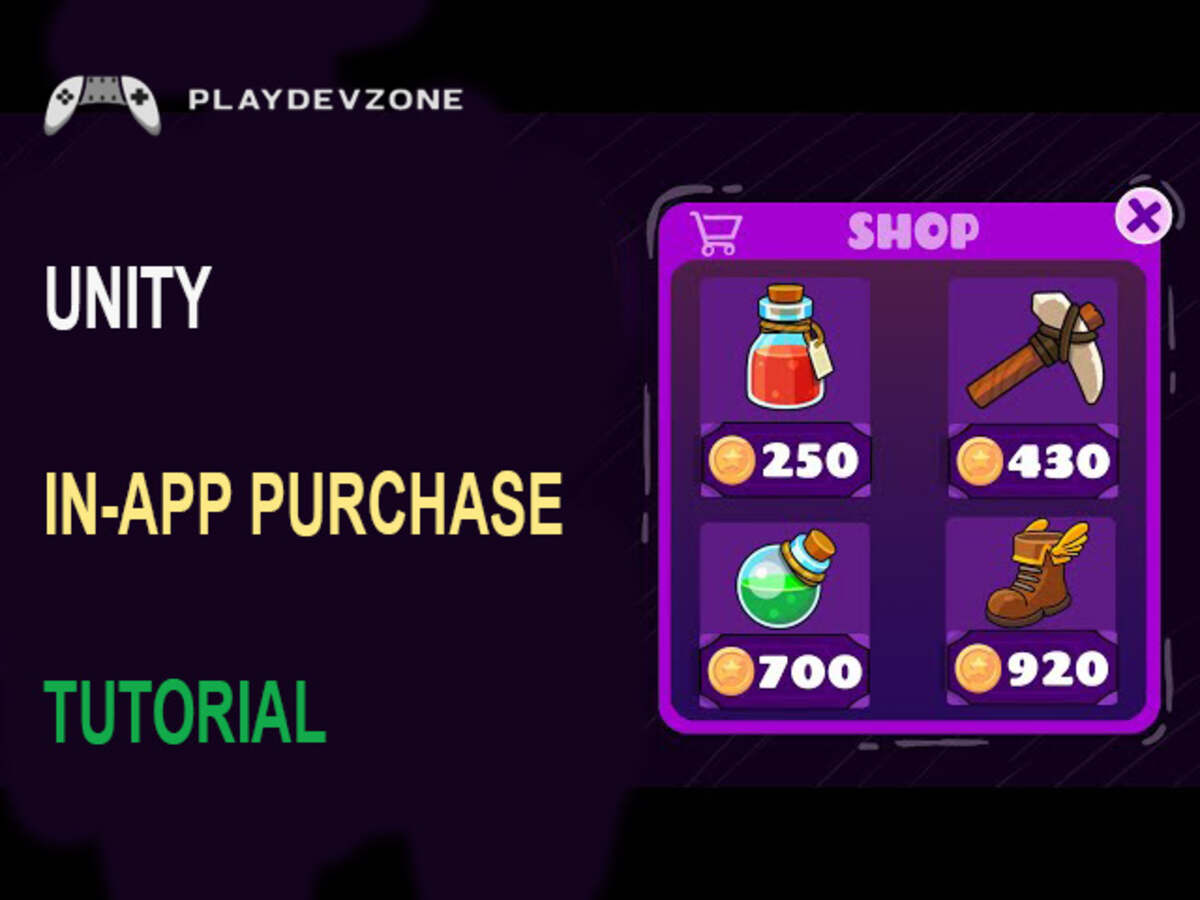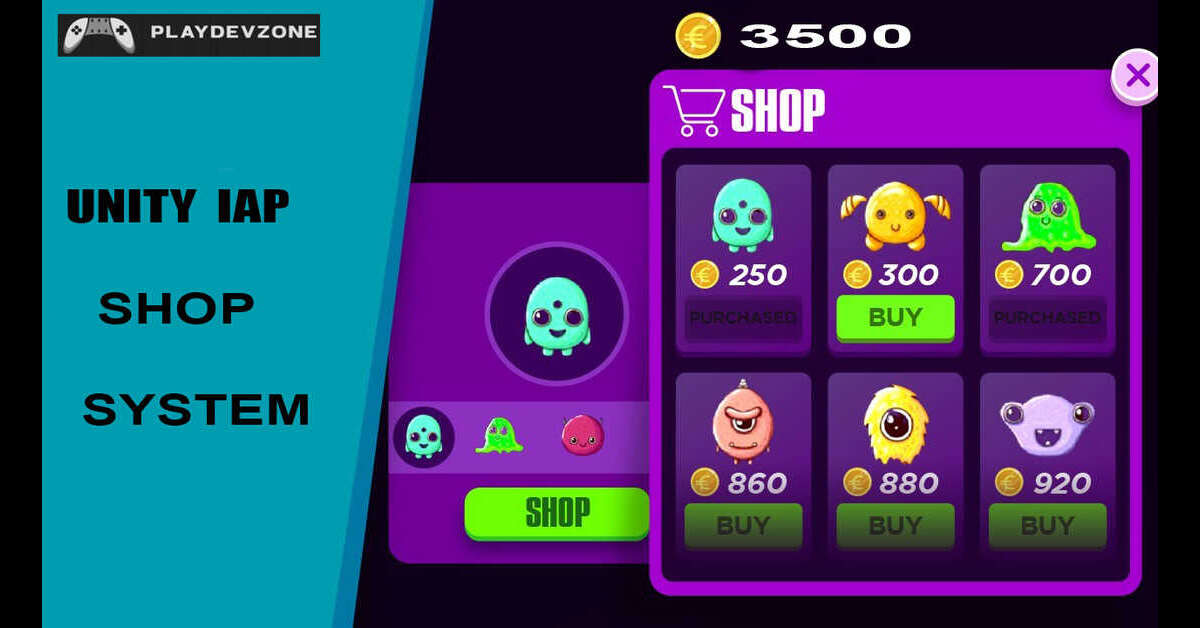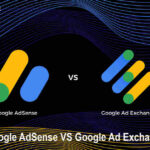Monetizing your mobile game doesn't have to be complicated.
With Unity's In-App Purchasing (IAP) system, you can seamlessly integrate digital purchases like power-ups, cosmetics, or subscriptions directly into your gameplay experience.

Whether you're an indie developer or part of a small studio, implementing IAP can be a game-changer for both player engagement and revenue generation.
In this Unity IAP tutorial, we’ll guide you through the entire process of adding purchases to your mobile game quickly and efficiently, with no headaches, no guesswork.
What Is Unity IAP?
Unity IAP (In-App Purchasing) is a built-in solution that allows developers to easily integrate in-app purchases into their Unity games across multiple platforms, including Android, iOS, and more.
It enables you to sell virtual goods such as coins, extra lives, premium content, or subscriptions directly within your game.
Unity IAP handles the complexities of interacting with app store APIs, product validation, and purchase processing so you can focus on the gameplay experience.
Whether you're a beginner or an experienced developer, Unity IAP streamlines monetization by offering a consistent and scalable approach to adding purchases, boosting both engagement and revenue.
Setting Up Your Project for Unity IAP
Before you can start selling in-game items, you need to properly set up your Unity project for In-App Purchasing (IAP).
Start by opening your project in Unity and navigating to the Package Manager. Search for and install "In-App Purchasing", which includes the necessary libraries to handle transactions.
Then, navigate to the Services panel in the Unity Editor and activate In-App Purchasing for your project to enable monetization features.
Be sure to configure your target platforms (iOS/Android) and link your game to the appropriate store accounts.
This setup ensures Unity can communicate with app stores and process purchases correctly.
With these steps complete, you're ready to define products and start implementing purchase logic in your game.
Configuring Products
Configuring products is a crucial step in enabling in-app purchases with Unity IAP.
Each item you want to sell, whether it’s a consumable like coins, a non-consumable like a character skin, or a subscription, needs a unique Product ID.
These IDs must match exactly between your Unity project and the app store (Google Play or Apple App Store).
In the Unity Editor, you'll define these products using the IAP Catalog or via code.
Be sure to assign the correct product type and double-check pricing, descriptions, and availability in your store dashboard.
Proper configuration ensures a smooth purchase experience and prevents errors during transaction processing.
Writing the IAP Logic
Once your products are configured, the next step is writing the IAP logic to handle purchases in your Unity game.
Start by implementing the IStoreListener and IStoreController interfaces, which allow your game to communicate with the app store.
Initialize the Unity IAP system using UnityPurchasing.Initialize(), then define how your game should respond to successful purchases, failed transactions, or restore actions.
In the ProcessPurchase method, grant the player their purchased content, like coins, lives, or premium access. It’s also important to handle edge cases gracefully, such as duplicate purchases or interrupted transactions.
By writing clean, reliable IAP logic, you ensure a smooth and secure buying experience for your players, which builds trust and encourages repeat purchases.
Testing In-App Purchases
Testing in-app purchases is a critical step before launching your game to ensure transactions work smoothly and securely.
While Unity’s Editor can simulate purchases for basic testing, real validation requires using sandbox environments provided by Google Play and Apple.
For Android, set up license testers in the Google Play Console; for iOS, use test users through App Store Connect.
Make sure to test all product types, consumables, non-consumables, and subscriptions under various scenarios, including failed transactions and network interruptions.
Monitor logs for any errors, and confirm that purchased content is delivered correctly.
Skipping proper testing can lead to poor user experiences and lost revenue, so don’t overlook this step.
Going Live: Publishing Your Game with IAP
Publishing your game with integrated In-App Purchases (IAP) requires careful preparation to ensure a smooth launch.
Before going live, double-check that all your products are correctly configured in the app stores Google Play Console and Apple App Store Connect, and that their Product IDs match exactly with your Unity project.
Submit your IAP items for review if required, as app stores often scrutinize digital purchases for compliance.
Make sure your app’s metadata, screenshots, and descriptions clearly communicate available purchases to users.
Conduct final end-to-end testing in the live environment’s sandbox mode to catch any last-minute issues.
With everything in place, release your game confidently, knowing your monetization system is ready to support players and maximize revenue from day one.
Tips for Optimizing IAP Strategy
Optimizing your In-App Purchase (IAP) strategy is key to maximizing revenue while maintaining a positive player experience.
Start by offering a mix of consumable and non-consumable products that appeal to different player types.
Price your items competitively and experiment with bundles or limited-time offers to create urgency.
Use clear, enticing descriptions and visuals to highlight the value of your products.
Integrate analytics tools to track purchase behavior, enabling data-driven adjustments to your offerings.
Avoid aggressive monetization tactics that frustrate users; instead, focus on providing meaningful value to encourage voluntary purchases.
Regularly update your IAP catalog based on player feedback and trends, keeping your game fresh and profitable over time.
Troubleshooting Common Unity IAP Issues
Optimizing your In-App Purchase (IAP) strategy is key to maximizing revenue while maintaining a positive player experience.
Start by offering a mix of consumable and non-consumable products that appeal to different player types.
Price your items competitively and experiment with bundles or limited-time offers to create urgency.
Use clear, enticing descriptions and visuals to highlight the value of your products.
Integrate analytics tools to track purchase behavior, enabling data-driven adjustments to your offerings.
Avoid aggressive monetization tactics that frustrate users; instead, focus on providing meaningful value to encourage voluntary purchases.
Continuously refine your in-app purchase catalog by analyzing player feedback and market trends, ensuring your game remains engaging and financially rewarding over time.
FAQ (Frequently Asked Questions)
How to add in app purchase in Unity?
To add in-app purchases (IAP) in Unity, start by installing the Unity IAP package via the Package Manager.
Next, enable In-App Purchasing under Services in the Unity Dashboard. Implement the IAP system by creating a script that uses the IStoreListener and IStoreController interfaces.
Define your products—such as coins or premium items with unique Product IDs that match those set up in the Google Play Console or Apple App Store Connect.
Use UnityPurchasing.Initialize() to set up the store, then handle purchases within the ProcessPurchase method.
Test transactions using sandbox accounts before going live. After thorough testing and validation, submit your game along with its in-app purchase items for review and approval by the app store.
With these steps, your Unity game will be ready to offer in-app purchases across platforms securely.
Is Unity IAP free?
Yes, Unity IAP (In-App Purchasing) is free to use with all Unity plans, including the free Personal plan.
There are no additional fees from Unity for integrating or using the IAP system in your game.
However, keep in mind that platform fees still apply to Google Play and the Apple App Store; they typically take a percentage (usually 15–30%) of each transaction.
Unity IAP acts as a bridge between your game and the store, handling purchase processing, validation, and product management across platforms.
It’s a powerful tool for monetization that doesn't cost anything upfront, making it an ideal choice for indie developers and small studios looking to generate revenue through mobile games.
How do I get paid from Unity games?
To earn money from your Unity games, you need to integrate monetization methods such as in-app purchases (IAP), ads, or premium downloads.
If you're using Unity IAP, payments are processed through the app stores (Google Play or Apple App Store), and those platforms, not Unity, pay out your revenue.
You must set up a developer account, add your banking and tax information, and meet minimum payout thresholds.
For ads, Unity Ads or third-party ad networks like AdMob can be integrated, and payments come directly from those networks.
Unity itself only pays developers if you're earning through Unity Ads or Unity Gaming Services.
Make sure you follow each platform's policies to ensure timely and accurate payments.
How to integrate in-app purchase?
To integrate in-app purchases (IAP) in your app or game, start by selecting a supported platform, such as Google Play, Apple App Store, or Unity IAP, for cross-platform support.
Set up a developer account with the respective store and define your in-app products (e.g., consumables, non-consumables, subscriptions).
To get started with in-app purchases in Unity, install the In-App Purchasing (IAP) package using the Unity Package Manager, which provides all the necessary tools to implement and manage purchases within your game.
Once installed, navigate to the Services window and activate In-App Purchasing to enable its functionality within your project.
Implement the purchasing logic using IStoreListener and IStoreController, and initialize the IAP system with UnityPurchasing.Initialize().
Handle successful and failed transactions in the ProcessPurchase method, ensuring content is delivered appropriately.
Finally, test purchases in the sandbox environment provided by the app store before publishing.
With proper integration, you can securely monetize your app and enhance the user experience.
Are in-app purchases profitable?
Yes, in-app purchases (IAPs) can be highly profitable when implemented strategically.
Many of the world’s top-grossing mobile games rely heavily on IAPs for revenue.
They enable players to purchase virtual items, unlock premium features, or expedite progress, often resulting in repeat purchases.
However, profitability depends on several key factors: your game’s design, user engagement, pricing strategy, and the seamless integration of purchases without disrupting gameplay.
Offering value-driven and non-intrusive IAPs encourages players to spend willingly.
Additionally, combining IAPs with analytics helps optimize your monetization approach over Time.
While not every game sees massive returns, a well-executed IAP model can generate steady income and even outperform traditional paid downloads.
Conclusion
Adding in-app purchases to your mobile game doesn’t have to be complicated, and with Unity IAP, it’s easier than ever.
By following this tutorial, you’ve learned how to set up your project, configure products, write the purchasing logic, and prepare your game for real-world transactions.
Whether you’re monetizing with consumables, non-consumables, or subscriptions, Unity IAP offers a robust, cross-platform solution to boost your game’s revenue without compromising user experience.
Remember, successful monetization isn’t just about adding purchases; it’s about offering value that players are happy to pay for.
Keep testing, refining, and optimizing your IAP strategy to create a game that’s both enjoyable and profitable.
Ready to turn your passion into profit? Your IAP-powered game is just a few clicks from going live.











